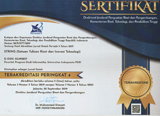Kendali Kecepatan Motor DC Menggunakan Pengendali PID dengan Encoder sebagai Feedback
(1) Universitas Singaperbangsa Karawang
(2) Universitas Singaperbangsa Karawang
(*) Corresponding Author
Abstract
PID (Proportional Integral Derivative) controllers are widely used to improve system response , as they offer clear, simple functionality and easy application and use. One of the important roles of the PID controller can be seen in its application to control and stabilize the angular velocity in the reference value of a direct current (DC) motor. The purpose of this research is to implement a PID controller as a DC motor speed controller so that it can understand the characteristics of each PID controller parameter on the system response curve. The test results show that each PID value parameter (Proportional, Integral, Derivative) has different characteristics to the system response. For example, adding the Kp parameter can reduce the steady-state error, reduce the rise time, but can increase the overshot value. Meanwhile, adding the Ki parameter can affect the increase in overshot, reduce the rise time, and reduce or even almost eliminate the steady state error value. Then, adding the Kd parameter can reduce the overshot, reduce the rise time, and increase the undershot.
Keywords
Full Text:
PDFReferences
T. J. D. Barnes, L. Wang, and W. R. Cluett, “Frequency domain design method for PID controllers,” Am. Control Conf., no. 2, pp. 890–894, 1993, doi: 10.23919/acc.1993.4792991.
W. Purbowaskito and C.-H. Hsu, “Sistem Kendali PID untuk Pengendalian Kecepatan Motor Penggerak Unmanned Ground Vehicle untuk Aplikasi Industri Pertanian,” J. Infotel, vol. 9, no. 4, p. 376, 2017, [Online]. Available: http://ejournal.st3telkom.ac.id/index.php/infotel/article/view/253
R. Muhardian and K. Krismadinata, “Kendali Kecepatan Motor DC Dengan Kontroller PID dan Antarmuka Visual Basic,” JTEV (Jurnal Tek. Elektro dan Vokasional), vol. 6, no. 1, pp. 328–339, 2020, [Online]. Available: http://ejournal.unp.ac.id/index.php/jtev/index
N. N. Rokhmah, “Kendali Kecepatan Motor DC dengan Metode PID Berbasis Arduino Uno,” 2018. [Online]. Available: http://repository.unjani.ac.id/index.php?p=show_detail&id=1031&keywords=
R. Arindya, “Penalaan Kendali PID untuk pengendali proses,” J. Teknol. Elektro, vol. 8, no. 2, p. 109, 2017.
I. Q. Rosalina Rosalina and M. Mujirudin, “Analisis Pengaturan Kecepatan Motor DC Menggunakan Kontrol PID (Proportional Integral Derivative),” Pros. Semin. Nas. Teknoka, vol. 2, pp. 89–94, 2017, [Online]. Available: https://journal.uhamka.ac.id/index.php/teknoka/article/view/782
R. A. Ardiansyah, “Perancangan dan Pengujian Sistem Pengendali Sudut untuk Motor DC Brushless Menggunakan Kendali Algoritma P-D,” J. Rekayasa Elektr., vol. 13, no. 2, p. 82, 2017, doi: 10.17529/jre.v13i2.7149.
E. Apriaskar, F. Fahmizal, N. A. Salim, and D. Prastiyanto, “Performance Evaluation of Balancing Bicopter using P, PI, and PID Controller,” J. Tek. Elektro, vol. 11, no. 2, pp. 44–49, 2019, doi: 10.15294/jte.v11i2.23032.
D. Irawan and P. Perdana SS, “Kontrol Motor Brushless DC (BLDC) Berbasis Algoritma AI - PID,” J. Tek. Elektro dan Komputasi, vol. 2, no. 1, pp. 41–48, 2020, doi: 10.32528/elkom.v2i1.3146.
A. Novandri, Roslidar, and A. Rahman, “Rancang Bangun Robot Self Balancing Berbasis Mikrokontroler Atmega328P Dengan Kendali Pid,” Kitektro, J. Online Tek. Elektro, vol. 2, no. 2, pp. 15–23, 2017.
DOI: http://dx.doi.org/10.30998/string.v7i1.13026
Refbacks
- There are currently no refbacks.
Copyright (c) 2022 Muhammad Reza Aditya Nurkholis Putera, Rahmat Hidayat

This work is licensed under a Creative Commons Attribution 4.0 International License.
STRING (Satuan Tulisan Riset dan Inovasi Teknologi) indexed by:

Ciptaan disebarluaskan di bawah Lisensi Creative Commons Atribusi 4.0 Internasional.
View My Stats


 Sertifikat Akreditasi
Sertifikat Akreditasi
















